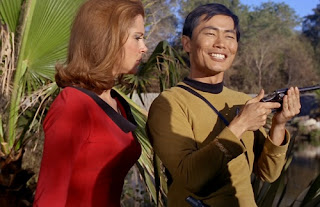For those who are new to my episode reviews, you can find the post where I establish my point criteria here
Overview – Quark makes a disturbing discovery in
some salvage that he has just purchased: a baby. The infant grows rapidly and
it soon becomes apparent that this is an infant Jem’Hadar. Odo takes on the
task to raise the child in a hope to convince it to move against its genetic
programing. Meanwhile, Commander Sisko gets to know the dabo girl that has been
dating his son Jake, and makes some surprising discoveries of his own.
Score: 7/10 – A good episode that provides the
audience with a better understanding of a new foe as well as develop the
characters of Odo, Ben, and Jake. The B-story line with the Siskos is fairly
routine and predictable, but adds some good filler. It could have been pared back
a bit to allow Odo’s story to develop a bit more, but it was still good.
Relevance - 3 points. More than anything else, this
grants us a deeper insight into the Jem’Hadar, establishing for the first time
that these super soldiers have been genetically modified to be lacking an
essential enzyme, which will later on be revealed as Ketracel-white. Odo shows
footage from the battle shown in “The Search”. We also see the promised dinner
between Ben Sisko and Mardah, the Bajoran dabo girl that Jake is currently
dating. There is also a repeat appearance of the Boslic freighter captain that
has had dealings with Quark.
Continuity - 3 points. Character continuity is solid.
Odo wanting to turn the young Jem’Hadar and in essence show that his people can
be redeemed works. Sisko as the overprotective father wrestling with the
romantic development between his teenage son and an older woman is typical
Character Development – 2 points. Odo shines in this
episode and grows the most. As he struggles to help the young Jem’Hadar
renounce the instincts built into his genetics, he must ultimately face the
truth that such an endeavour is doomed. He has a conflict with Kira over the
issue, but true to their relationship they stay closely connected. Jake’s
writing is further developed as it is what drew Martah to him.
Social Commentary – 3 points. I had a hard time
deciding whether this would score two or three points. I did a lot of research
and discovered that there are many different ideas and concepts that are being
explored here. The Sisko story line shows how our children seem to grow up
without us parents really noticing, and that we can still be surprised by them.
The main story line gives us a chance to explore some deeper subject matter.
Director Avery Brooks compared the story to an exploration of racial issues,
specifically in gang culture. It is difficult to take someone out of a culture
that has spent so much time conditioning them. Writer and producer Rene
Echevarria described the story as a tragedy in that the Jem’Hadar youth could
not be turned and redeemed. So many times we hope to be able to influence
someone for good and help them change the pathway that they are on, only to learn
that their effort is futile. I think many of us know someone whom we have tried
to help overcome something deeply rooted in their life, such as addictions or
negative cultural issues, but in the end realize that we just cannot help them.
Cool Stuff – 2 points. A point is scored for the more
in-depth exploration into the growth of a Jem’Hadar soldier. This is the only
chance we get to see how the Jem’Hadar start out it in life. It is very cool.
It is also a nice insight into Jake. The realizations that Ben have about his
son further strengthens their relationship. Cool point for that.
Rank – Captain (17
points). A
solid outing that gives us our only glimpse at the life of a young Jem’Hadar.
The Odo story is solid, and the B-line story with the Siskos is decent.
If you would like to read other reviews from Star Trek: Deep Space Nine, please click the following link.
If you would like to read an episode review from any of the Trek series, click the following link to get to the series catalog. If the episode you want reviewed has not been done yet, then feel free to request it in the comments and I will see what I can do.




















































